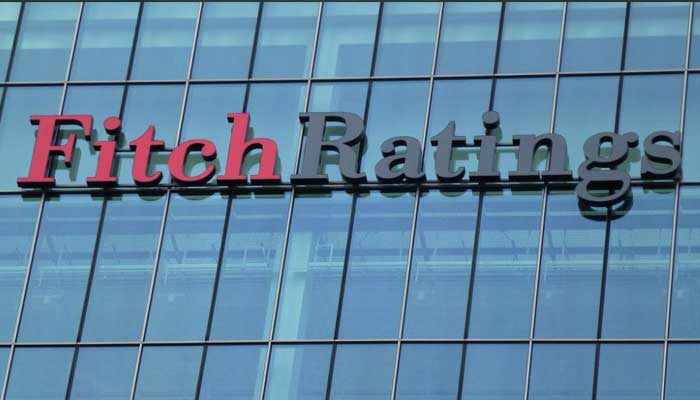Fitch downgrades Pakistan’s rating to ‘B-’ on heightened external financing risk
KARACHI: Ratings agency Fitch has downgraded Pakistan’s long-term foreign currency issuer default rating to ‘B-’ from ‘B’ on heightened external financing risk and elevated foreign debt repayments, as well as deteriorating fiscal position.
The US credit ratings agency, however, said in a statement on Friday the outlook is stable.
Fitch Ratings said a successful conclusion of ongoing negotiations on the International Monetary Fund (IMF) support could help stabilise external finances, “but the program would then face significant implementation risk”.
“Successful negotiations could attract more stable and sustained financing by opening up budget support from the World Bank and the Asian Development Bank, and by improving access to bilateral lending and global capital markets,” it added. “Implementation risks would be high in light of uneven adherence to previous programs.”
Fitch estimated that liquid foreign exchange reserves would continue falling to seven billion dollars for the current fiscal year of 2018/19 in the absence of an IMF program.
The credit ratings agency, however, forecast the current account deficit to narrow to 5.1 percent of GDP in FY2019 and to 4 percent in FY2020, from a revised 6.1 percent in FY2018.
Fitch Ratings said rupee depreciation, lower oil prices and newly-imposed import duties will drive a deceleration in imports, while exports are likely to strengthen gradually.
“Bilateral financial assistance, including $3 billion in short-term financing from Saudi Arabia (in addition to $3 billion in deferred oil payments) along with undisclosed commitments from China and the UAE, has helped plug the near-term financing gap.”
The ratings agency said higher external debt service payments relative to last year is likely to offset an expected narrowing of the current account deficit.
Fitch said sovereign debt-service obligations over the next three years amount to $7 billion to 9 billion per year, including a $1 billion Eurobond repayment due in April 2019.
“External debt servicing will stay high throughout the next decade, with China Pakistan Economic Corridor-related (CPEC) outflows set to begin in the early 2020s.”
The ratings agency forecast public debt to GDP ratio to 75.6 percent of GDP in FY2019 on additional rupee depreciation from 72.5 percent in FY2018 and 67 percent in FY2017.
“Debt is mainly denominated in local currency, but the pace of external borrowing has increased in the past two years,” it said.
Fitch Ratings projected GDP growth to fall to 4.2 percent in the current fiscal year compared to a 13-year high of 5.8 percent in the last fiscal year, “as monetary and fiscal tightening measures begin to weigh on activity”.
“However, this remains above the current ‘B’ category median GDP growth of 3.5 percent,” it said. “Reduced infrastructure capacity constraints, particularly in the energy sector, following CPEC investments, along with improved national security, could support growth in the medium term.”
Fitch expected inflation to increase to an average of 7 percent in 2018/19 as it has risen due to significant rupee depreciation and higher energy prices.
The ratings agency forecast the fiscal deficit to narrow to 5.6 percent of GDP in FY2019, from 6.6 percent in FY2018, as the new government rolled back the previous government’s tax relief plans, implemented new revenue measures and cut development expenditure.
“Better fiscal coordination between the federal and provincial governments is also planned through the fiscal coordination committee,” it said.
Fitch further said ongoing domestic threats, geopolitical tensions with neighbouring countries and issues around compliance with the intergovernmental Financial Action Task Force standards continue to weigh on investor sentiment despite domestic security has improved.
Fitch Ratings said implementation of an effective external account’s policy, sustained fiscal consolidation and improved export and growth prospects are the main factors that could lead to a positive rating.
-
 Piers Morgan Finally Reacts To Brooklyn Beckham's Statement About David And Victoria Beckham
Piers Morgan Finally Reacts To Brooklyn Beckham's Statement About David And Victoria Beckham -
 Tom Hiddleston Reveals Unlikely DC Character That Inspired Loki
Tom Hiddleston Reveals Unlikely DC Character That Inspired Loki -
 Prince Harry, Meghan Markle Warned 2026 Will Be 'a Big Test' For Them
Prince Harry, Meghan Markle Warned 2026 Will Be 'a Big Test' For Them -
 OpenAI Plans First ChatGPT Device For 2026
OpenAI Plans First ChatGPT Device For 2026 -
 Matt Damon Gets Slammed Over 'out Of Touch' Comparison
Matt Damon Gets Slammed Over 'out Of Touch' Comparison -
 From Chagos Islands To Greenland Trump Flags National Security Risks: Here’s Why
From Chagos Islands To Greenland Trump Flags National Security Risks: Here’s Why -
 Meghan’s UK Return As ‘successful Businesswoman’ Will Put Pressure On Kate Middleton
Meghan’s UK Return As ‘successful Businesswoman’ Will Put Pressure On Kate Middleton -
 Spotify Tests Page Match To Sync Books With Audiobooks
Spotify Tests Page Match To Sync Books With Audiobooks -
 King Charles Breaks Cover Amid Prince Harry's Presence In Britain
King Charles Breaks Cover Amid Prince Harry's Presence In Britain -
 Real Reason King, William, Kate Have Arranged To Avoid Harry During UK Trip
Real Reason King, William, Kate Have Arranged To Avoid Harry During UK Trip -
 Trump Trolls European Leaders With AI Map Showing Greenland As U.S. Territory
Trump Trolls European Leaders With AI Map Showing Greenland As U.S. Territory -
 AI Vs Reality: How Deepfakes Are Warping Story Of Maduro’s US Capture
AI Vs Reality: How Deepfakes Are Warping Story Of Maduro’s US Capture -
 Why Ryan Coogler Got Worried After Pitching 'Sinners' To Michael B Jordan
Why Ryan Coogler Got Worried After Pitching 'Sinners' To Michael B Jordan -
 Princess Diana's Brother Shares Emotional Post After Prince Harry Returns To UK Without Meghan, Archie, Lilibet
Princess Diana's Brother Shares Emotional Post After Prince Harry Returns To UK Without Meghan, Archie, Lilibet -
 'Disgraced' Andrew Gets Away With Major Double Standard Over Royal Lodge
'Disgraced' Andrew Gets Away With Major Double Standard Over Royal Lodge -
 Carson Beck Girlfriend Rumours Explained Amid CFP Championship Run
Carson Beck Girlfriend Rumours Explained Amid CFP Championship Run




